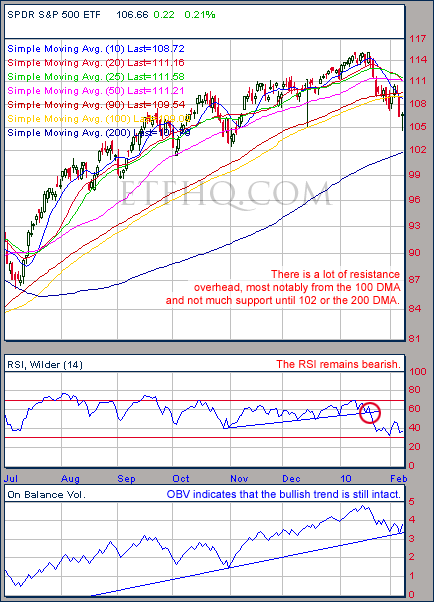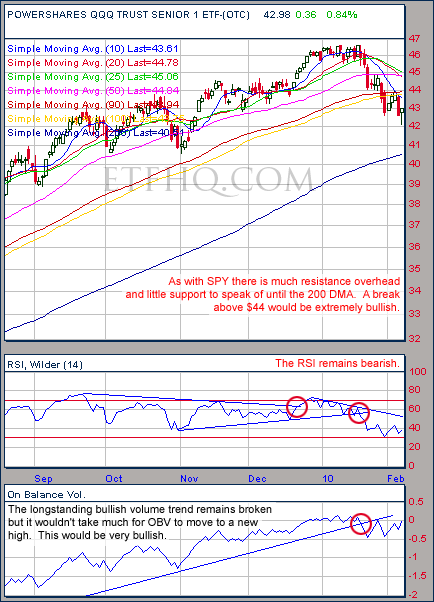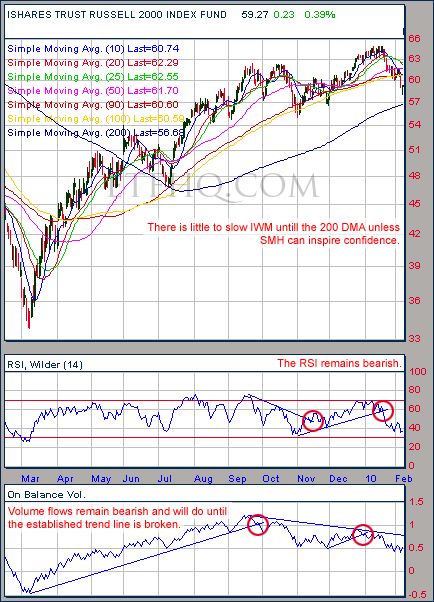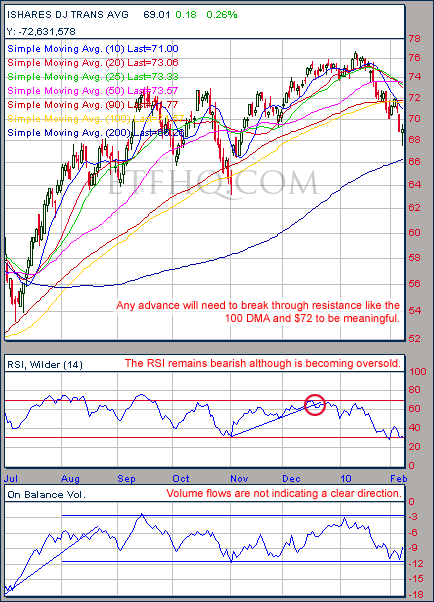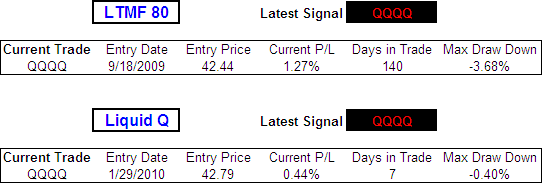February 08, 2010 – 6:47 am ET
This past week we saw some impressive declines and along with some impressive bounces off major support levels. The most bullish thing we have seen in a while was how violently SMH bounced off its 200 day moving average. This level will become pivotal in ensuring the continued health of the broad market.
ETF % Change Comparison

SMH ended up as the top performer for the week followed by QQQQ while IYT and IWM were the biggest laggards. To see the economically sensitive stocks in SMH and QQQQ rebound on Friday was a positive development however this could just be a bounce caused my a combination of support and becoming oversold.
What the % Comparison Table Tells Us:
By comparing the performance of the economically sensitive (SMH, QQQQ, IWM, IYT) and the comparatively stable ETFs (SPY and DIA) we can get an indication of the true market direction. The more sensitive areas of the market tend to be the first to initiate a trend change. For example if DIA and SPY sell off heavily while SMH and IWM (Russell 2000 small cap ETF) sell of mildly or continue moving to new highs then this would be very positive and vice versa.
The ‘Average Rank %’ is calculated by subtracting the % change for each ETF from the maximum % change and dividing it by the range for each period. 1-((MAX(% change all ETFs)-ETFs % Change)/(MAX(% change all ETFs)-MIN(% change all ETFs))) The readings for each period are then averaged. This reading is provided because if one ETF was significantly under/out performing the others then a plain high or low rank would not accurately reflect this.
A Look at the Charts
Volume flows are maintaining their bullish trend which is a positive sign. Although it is concerning to see so little support between the current levels and the 200 day MA. If SPY can move higher then there are still solid resistance levels above. Look to SMH for a clearer picture.
Suddenly volume flows for QQQQ don’t look so bad. A few more good days and OBV will be moving to new highs and that would be a very good sign. If that were to occur in conjunction with a move above $44 then the bulls would have the upper hand again.
Here we have reached a critical point. Can SMH hold onto support from the 200 day MA? If it can then this will be the fuel that the market needs to take on overhead resistance. If not and $24 is also broken then things could really get nasty. Volume flows indicate that support is unlikely to hold so if you were to watch only one ETF this coming week then SMH would be it.
Volume flows on the small caps are in a firm down trend. There is strong support around $57 and from the 200 day MA. With OBV sitting below the November low there is a good chance that support will fail. The only thing that is likely to stop a test of support is strength from SMH.
Volume flows from the Dow Transportation ETF continue to move in a sideways trend. With the RSI approaching oversold territory this could indicate that a bounce is due however a move in either direction will be meaningless until there is a breach of resistance around $72 or support around $66.
OM3 Weekly Indicator
The OM3 indicator is showing a ‘Strong Sell’ for all of the ETFs we track and several of them for the 3rd week. In addition to this they have all had several weeks of ‘Bear Alert’ warnings.
How to read the OM3 indicator
The OM3 indicator as with most of our models primarily reads price action and volume. The strong/weak buy/sell signals are self-explanatory. ‘No Signal’ means that the component readings are in conflict and cancel each other out.
The alerts let you know if the cycle is speeding up or slowing down, so when you get at ‘Strong Buy, Bear Alert’ for instance it simply means that the criteria for a strong buy is still in place but this weeks reading is weaker (or more bearish) than last weeks reading (the same is true in reverse).
The number of weeks that a signal has been repeated is displayed. Historically a ‘Strong Buy’ signal has lasted for an average of 6 weeks and a maximum of 42 weeks, while a ‘Strong Sell’ has lasted for an average of 4 weeks and a maximum of 16.
This is an indicator not a mechanical trading model. It is useful to assist in analyzing the market but for the best results should be combined with commonsense and support/resistance levels etc.
TransDow & NasDow
The Dow remains dominant over the DJ Transportation Index and the NASDAQ. This indicates that there is a high level of risk in the market.
What the TransDow Readings tell us:
The TransDow measures dominance between the DJ Transportation Index (DJTI) and the Dow Jones Industrial Average (DJIA). In a strong market the more economically sensitive Transportation Index should be dominant over the DJIA.
Historically the DJTI has been dominant over the Dow 45% of the time. The annualized rate of return from the DJTI during this period was 18.47% with the biggest loss for one trade sitting at -13.27%. The annualized rate on the DJIA during the periods it was dominant over the DJTI was just 4.06% and the biggest loss for one trade was -16.13%. A 4% stop-loss is applied to all trades adjusting positions only at the end of the week.
What the NasDow Readings tell us:
The NasDow measures dominance between the NASDAQ and the DJIA. Using the same theory behind the Trans Dow; in a strong market the more economically NASDAQ should be dominant over the DJIA.
Historically the NASDAQ has been dominant over the DJIA 44% of the time. Taking only the trades when the NASDAQ is above its 40 week moving average the annualized rate of return was 25.47% with the biggest loss for one trade sitting at –8.59%. The annualized rate on the DJIA during the periods it was dominant over the NASDAQ is just 8.88% and the biggest loss for one trade was –12.28%. A 8% stop-loss is applied to all trades adjusting positions only at the end of the week.
LTMF 80 & Liquid Q
Both LTMF 80 and Liquid Q are on buy signals and showing small profits from the current trades. It is bullish to see these signals are active especially as Liquid Q is only in the market 27% of the time. Both systems aim to capture big moves over a timeframe that usually stretches into months.
Historical Stats:
Summary
For the bullish argument there was some impressive upside leadership from SMH and QQQQ on Friday as they found buyers at major support levels. Volume flows on SPY remain bullish and QQQQ’s OBV is not far from a new high. If resistance overhead were to be broken such as QQQQ closing above $44 then this would be very bullish.
The key thing to watch for this week is whether SMH can maintain support from its 200 day MA, if this fails then support at $24 is also likely to fail. Should this happen then expect support levels to start crumbling across market. The next most important support is the 200 day moving average from the Russell 2000 ETF – IWM.
For the bearish argument, nearly every major stock and ETF is below its 50 day MA and has strong resistance overhead most commonly in the form of the 100 day MA. Volume flows for SMH and IWM are clearly bearish and below their November lows indicating that support levels are unlikely to hold.
By looking at the major holdings of an index or ETF you can often reveal a lot about its internal strength. Some funds have 25% or more of their holdings in just a few stocks. SMH for instance has 57.88% of is holdings in only three stocks; INTC @ 23.47%, TXN @ 21.18% and AMAT @ 13.23%.
If you have a look you will see volume flows for INTC are moving sideways along with the stock price and there is staunch support around $19. Volume flows on TXN are clearly bearish while the volume flows on AMAT are actually looking quite healthy and are significantly outperforming the price action. I would expect AMAT to be the top performer of the three if there were a rebound this week. INTC is still above its 200 day MA while TXN and AMAT have already broken through this support level. For the market to recover this week it will be important for INTC to maintain support @ $19 so keep an eye on this as well.
The bulls are going to need to fight hard this week to maintain these key support levels or there is little chance that the bull market can continue.
Any disputes, questions, queries… comments or theories are most welcome below.
Best Regards
Derry
And the Team @ ETF HQ
Quote Of The Day
"Everything’s tested in historical markets. The past is a pretty good predictor of the future. It’s not perfect. But human beings drive markets, and human beings don’t change their stripes overnight. So to the extent that one can understand the past, there’s a good likelihood you’ll have some insight into the future."
– James Simons
